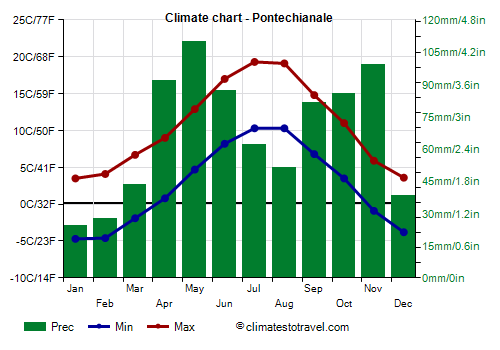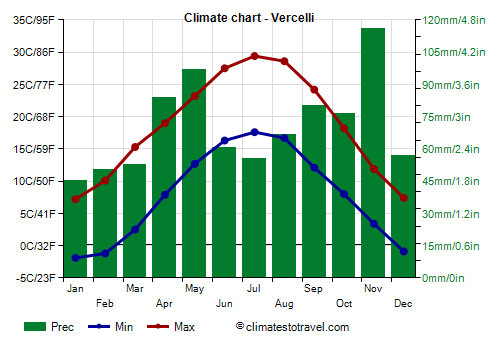Select units of measurement for the temperature and rainfall tables (metric or imperial).
Average weather, temperature, rainfall, sunshine hours
Introduction
In Piedmont, we have the following types of climate:
- In the west and north, the cold mountain climate of the
Alps. In the north, in the
Pre-Alps, and in the south, in the
Apennines, we instead have a temperate humid climate.
- In the central-eastern part, the semi-continental climate of the
Po Valley.
Piedmont, the second largest Italian region by surface area, is located in the north-west of the country, and has no access to the sea. To the south, the Ligurian
Apennine separates Piedmont from the sea. To the west and north we find the
Alps: to the west, on the border with France, the Maritimes, Cottian and Graian Alps, while to the north, on the border with the Valle d'Aosta region and Switzerland, the Pennine and Lepontine Alps.
The Alps protect the region from cold air irruptions from the north, but also from the cool, humid wind from France. Occasionally, the wind manages to climb over the ridge and appears in the Alpine and pre-Alpine valleys, but sometimes also in the plains, in the form of a warm, dry wind, the
föhn, which is able to bring clear skies and good visibility. When the föhn blows, the temperature can exceed 15 °C (59 °F) even in the middle of winter.
The Apennines are lower, so they are unable to prevent the rains from arriving from the Ligurian Sea, even though they block the southerly wind at low altitudes.
Within the flat area, we find
hills. Near Turin we find the Po hills, while to the south-east we find the Langhe, Roero and Monferrat hills.
The
Po river originates from Monviso and crosses the regional capital, Turin, which is located at an altitude of 250 metres (820 feet).
To the north-east we find some lakes, the main ones being
Lake Maggiore, shared with Lombardy to the east and the Canton of Ticino to the north, and Lake Orta.
Precipitation is more abundant in the north, in the Pre-Alps, in the province of Verbano-Cusio-Ossola, west of Lake Maggiore, where it can even exceed 2,000 millimeters (80 inches) per year. Another very rainy area is the southernmost one, on the Ligurian Apennines. The least rainy area of Piedmont is the south-eastern plain, in the provinces of Asti and Alessandria, where precipitation drops below 650 mm (25.5 in) per year.
Mountains
In the mountains of Piedmont, there are some ski resorts such as Sestriere, Bardonecchia and Alagna Valsesia.

In
Pontechianale, located at 1,650 meters (5,400 ft) in the province of Cuneo, the average temperature ranges from -0.5 °C (31 °F) in January to 15 °C (59 °F) in July. Here are the average temperatures.
Pontechianale - Average temperatures (1991-2020) |
| Month | Min | Max | Mean |
|---|
| January | -4.7 | 3.5 | -0.6 |
|---|
| February | -4.6 | 4.1 | -0.2 |
|---|
| March | -1.9 | 6.7 | 2.4 |
|---|
| April | 0.8 | 9 | 4.9 |
|---|
| May | 4.7 | 12.9 | 8.8 |
|---|
| June | 8.2 | 17 | 12.6 |
|---|
| July | 10.3 | 19.3 | 14.8 |
|---|
| August | 10.3 | 19.1 | 14.7 |
|---|
| September | 6.8 | 14.8 | 10.8 |
|---|
| October | 3.5 | 11 | 7.2 |
|---|
| November | -0.9 | 5.9 | 2.5 |
|---|
| December | -3.8 | 3.6 | -0.1 |
|---|
| Year | 2.4 | 10.6 | 6.5 |
|---|
Precipitation amounts to 800 mm (31.5 in) per year.
Pontechianale - Average precipitation| Month | Days |
|---|
| January | 24 | 6 |
|---|
| February | 28 | 6 |
|---|
| March | 43 | 7 |
|---|
| April | 92 | 10 |
|---|
| May | 110 | 12 |
|---|
| June | 87 | 10 |
|---|
| July | 62 | 8 |
|---|
| August | 52 | 8 |
|---|
| September | 82 | 8 |
|---|
| October | 86 | 8 |
|---|
| November | 99 | 9 |
|---|
| December | 38 | 7 |
|---|
| Year | 800 | 99 |
|---|
The highest peak in Piedmont is
Nordend, 4,609 metres (15,121 ft), belonging to the Monte Rosa ("Pink Moutain") massif, whose peak is located in Switzerland (although very close to the border).
At the
Capanna Regina Margherita, at 4,560 meters (14,961 ft) on Monte Rosa, the average temperature ranges from -19.5 °C (-3 °F) in February to -4 °C (25 °F) in July and August, when the maximum reaches around 0 °C (32 °F). However, when the African anticyclone arrives, the temperature can go above freezing. In February 2012, the temperature dropped to -37 °C (-34.5 °F), while at the end of June 2019 it reached 10 °C (50 °F). Here are the average temperatures.
Capanna Margherita - Average temperatures (2002-2020) |
| Month | Min | Max | Mean |
|---|
| January | -21.9 | -15.6 | -18.8 |
|---|
| February | -22.8 | -16.2 | -19.5 |
|---|
| March | -20.8 | -13.9 | -17.4 |
|---|
| April | -17.5 | -10 | -13.8 |
|---|
| May | -14.2 | -6.3 | -10.2 |
|---|
| June | -9.4 | -2.2 | -5.8 |
|---|
| July | -7.7 | -0.3 | -4 |
|---|
| August | -7.7 | -0.5 | -4.1 |
|---|
| September | -10 | -3.3 | -6.6 |
|---|
| October | -12.9 | -6.9 | -9.9 |
|---|
| November | -17.4 | -11.8 | -14.6 |
|---|
| December | -21.2 | -15.2 | -18.2 |
|---|
| Year | -15.2 | -8.5 | -11.85 |
|---|
Plain
In the flat area of Piedmont, there is a
moderately continental climate, with cold, damp winters and hot, muggy summers.

For example, in
Vercelli, the average temperature ranges from -2.5 °C (27.5 °F) in January to 23.5 °C (74.5 °F) in July.
Vercelli - Average temperatures (1991-2020) |
| Month | Min | Max | Mean |
|---|
| January | -1.9 | 7.2 | 2.7 |
|---|
| February | -1.2 | 10.1 | 4.4 |
|---|
| March | 2.5 | 15.3 | 8.9 |
|---|
| April | 7.9 | 19 | 13.4 |
|---|
| May | 12.7 | 23.2 | 18 |
|---|
| June | 16.3 | 27.5 | 21.9 |
|---|
| July | 17.6 | 29.4 | 23.5 |
|---|
| August | 16.7 | 28.6 | 22.6 |
|---|
| September | 12.1 | 24.2 | 18.2 |
|---|
| October | 8 | 18.2 | 13.1 |
|---|
| November | 3.4 | 11.9 | 7.6 |
|---|
| December | -0.9 | 7.4 | 3.2 |
|---|
| Year | 7.8 | 18.5 | 13.15 |
|---|
Precipitation amounts to 840 mm (33 in) per year.
Vercelli - Average precipitation| Month | Days |
|---|
| January | 45 | 5 |
|---|
| February | 50 | 4 |
|---|
| March | 52 | 4 |
|---|
| April | 84 | 8 |
|---|
| May | 97 | 8 |
|---|
| June | 61 | 6 |
|---|
| July | 55 | 5 |
|---|
| August | 67 | 6 |
|---|
| September | 80 | 6 |
|---|
| October | 76 | 7 |
|---|
| November | 116 | 8 |
|---|
| December | 57 | 5 |
|---|
| Year | 840 | 73 |
|---|
In Piedmont we find the westernmost part of the Po Valley, which, being enclosed by mountains on three sides, is the one where
cold air stagnates the most in
winter. The average temperatures in January are 2.5/3 °C (36.5/37.5 °F). This is an area with little wind, where pollutants accumulate, especially in the cold period, from November to March. In winter, during periods of high pressure,
fog hangs over the Piedmont plain, while the sun shines on the Ligurian coast, and between the cities of Alessandria and Genoa, 55 km (35 mi) away but with the Apennines between, there can be more than 10 degrees Celsius (18 °F) of difference.
Even in
summer, the air tends to stagnate, however, a bit of breeze from the sea can arrive in the southern part (when it manages to cross the Apennines), moreover, in the west and north there can be infiltrations of cool, humid air from France, which can lead to thunderstorms. The average temperatures in July are 24/24.5 °C (75/76 °F).
During
heat waves, which are becoming increasingly more frequent, the temperature can reach or exceed 35 °C (95 °F). The heat records are 40 °C (104 °F) in the plain south of the Po (see
Alessandria,
Asti), while they are of 36/37 °C (97/99 °F) in the northern part of the plain (see Vercelli,
Novara) and in the cities at the foot of the mountains (see
Turin,
Biella,
Verbania).

On average, Piedmont is the snowiest region in Italy. The
snow can fall both with the wind from the east (especially in the western part, see Turin), with the wind from the south (especially in the north, see Verbania), and with the wind from the north-east (in the southern part, see Asti and Alessandria). In
Cuneo, at 550 meters (1,800 ft) in the southwest of the region, more than a meter of snow (39.5 in) falls per year.
Every now and then,
cold air masses from Eastern Europe can bring quite intense frosts, though the temperature rarely drops below -10 °C (14 °F). Together with western Emilia, Piedmont is the Italian region where the lowest temperatures are recorded, and during the most intense cold spells, such as that of February 1956 and February 2012, the temperature locally dropped below -20 °C (-4 °F).
Best Time
The
best period to visit the cities of the Piedmont plain is that of spring and early summer, and in particular, from mid-April to mid-June. September, too, is a good month. However, you have to take into account some rainy days in both periods.
Summer can be hot, although some days can be acceptable, especially in June. In summer, and sometimes in May, sudden thunderstorms in the afternoon or evening must be put into account. Indeed, it must be said that May in Piedmont is often the rainiest month of the year, especially in the western and northern parts.
You can go to the Alps either in winter, perhaps for skiing, and in summer, perhaps for trekking in the mountains and to escape the heat of the plains.
See also the
temperatures by month.